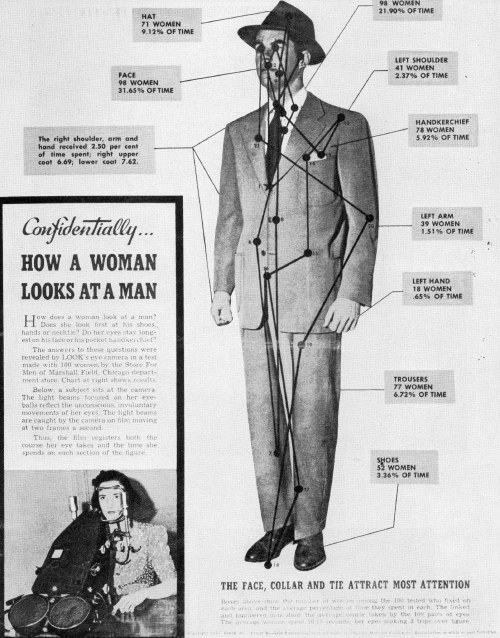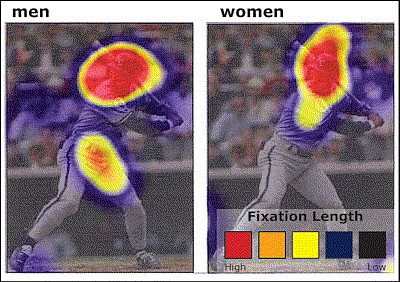What do women look at?
One of the earliest eyetracking studies was conducted by the Visual Research Laboratories at Drake University during the 1940s. They used light beams to follow the eyeball movements of women shown a picture of a man. The subjects were all customers at the Marshall Field department store in Chicago. Check out this diagram they produced titled "How a Woman Looks at a Man" (from Look magazine, 1944).

An eyetracking study conducted in 2005 by the Nielsen/Norman Group (described in Online Journalism Review) produced similar results. When shown a photo of baseball-player George Brett, womens' eyes focused on his face. By contrast, when men were shown the same photo, they focused also on his crotch. The researchers noted, "Men tend to fixate more on areas of private anatomy on animals as well, as evidenced when users were directed to browse the American Kennel Club site." (This is one of those factoids that doesn't make me feel proud to be a man.)

But what about less tame material? Of course, science has explored this area as well. A 2007 study funded by the Center for Behavioral Neuroscience analyzed the viewing patterns of men and women shown sexual photographs. Strangely enough, the viewing patterns were not the same as in the earlier studies. From Science Daily:

An eyetracking study conducted in 2005 by the Nielsen/Norman Group (described in Online Journalism Review) produced similar results. When shown a photo of baseball-player George Brett, womens' eyes focused on his face. By contrast, when men were shown the same photo, they focused also on his crotch. The researchers noted, "Men tend to fixate more on areas of private anatomy on animals as well, as evidenced when users were directed to browse the American Kennel Club site." (This is one of those factoids that doesn't make me feel proud to be a man.)

But what about less tame material? Of course, science has explored this area as well. A 2007 study funded by the Center for Behavioral Neuroscience analyzed the viewing patterns of men and women shown sexual photographs. Strangely enough, the viewing patterns were not the same as in the earlier studies. From Science Daily:
Researchers hypothesized women would look at faces and men at genitals, but, surprisingly, they found men are more likely than women to first look at a woman's face before other parts of the body, and women focused longer on photographs of men performing sexual acts with women than did the males...
"The eye-tracking data suggested what women paid most attention to was dependent upon their hormonal state. Women using hormonal contraceptives looked more at the genitals, while women who were not using hormonal contraceptives paid more attention to contextual elements of the photographs," Rupp said.
"The eye-tracking data suggested what women paid most attention to was dependent upon their hormonal state. Women using hormonal contraceptives looked more at the genitals, while women who were not using hormonal contraceptives paid more attention to contextual elements of the photographs," Rupp said.
Comments
Commenting is not available in this channel entry.

Category: Sexuality | Experiments